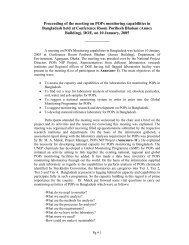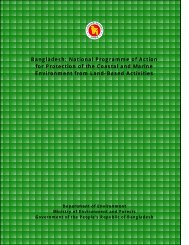Draft CMP HH - the Department of Environment
Draft CMP HH - the Department of Environment
Draft CMP HH - the Department of Environment
You also want an ePaper? Increase the reach of your titles
YUMPU automatically turns print PDFs into web optimized ePapers that Google loves.
Coastal and Wetland Biodiversity Management Project BGD/99/G31<br />
Hakaluki Haor <strong>Draft</strong> Conservation Management Plan<br />
• Implement <strong>the</strong> species recovery plans in close collaboration with local community groups and<br />
relevant government authorities<br />
• Identify critical wildlife habitats and work with local community groups and relevant<br />
government agencies to ensure that <strong>the</strong>se sites come under appropriate protection as sanctuaries<br />
• Identify <strong>the</strong> key threats to wildlife in <strong>the</strong> Haor and develop recommendations aimed at<br />
mitigating in <strong>the</strong> short-term <strong>the</strong> most serious <strong>of</strong> <strong>the</strong>se threats<br />
• Update inventory/ database <strong>of</strong> wildlife species at Hakaluki Haor<br />
• Organise education and awareness raising activities which promote an understanding <strong>of</strong> <strong>the</strong> need<br />
for wildlife conservation in Hakaluki Haor<br />
• Build <strong>the</strong> capacity <strong>of</strong> local community groups to undertake on-going monitoring <strong>of</strong> wildlife<br />
populations at Hakaluki Haor<br />
• Ensure that all wildlife surveys are part <strong>of</strong> an integrated ecological monitoring programme for<br />
Hakaluki Haor<br />
• Review <strong>the</strong> legal and policy framework which regulates <strong>the</strong> protection <strong>of</strong> wildlife and propose<br />
amendments which more effectively support <strong>the</strong>ir conservation<br />
Primary Outcome/ Output<br />
• Wildlife is protected, numbers are increasing, and threatened species are recovered<br />
Constraints<br />
• Community groups may not be interested to become involved in wildlife monitoring activities<br />
• Slow initiation <strong>of</strong> wildlife conservation activities may result in <strong>the</strong> loss <strong>of</strong> more species<br />
• Disagreements between community groups and government agencies may arise <strong>of</strong> <strong>the</strong><br />
nomination <strong>of</strong> sites as wildlife sanctuaries<br />
7.1.3 Fish and Fishing<br />
The Hakaluki Haor wetland ecosystem is an important habitat for a large variety <strong>of</strong> freshwater fish.<br />
Most recent data suggests that <strong>the</strong>re are a total <strong>of</strong> 107 different species fish that inhabit <strong>the</strong> complex<br />
<strong>of</strong> Haor aquatic habitats including beels, canals, rivers, and floodplains. For fish management<br />
purposes <strong>the</strong> most important rivers have been identified as <strong>the</strong> Kushiara, Bardol, Juri, and Fanai as<br />
<strong>the</strong>y are responsible for feeding <strong>the</strong> floodplains outside <strong>of</strong> <strong>the</strong> ECA which are important breeding<br />
grounds for fish in <strong>the</strong> summer months <strong>of</strong> rain. During <strong>the</strong> winter, as <strong>the</strong> water level begins to drop,<br />
<strong>the</strong> fish accompanied by <strong>the</strong>ir young return to <strong>the</strong> river and beel systems <strong>of</strong> <strong>the</strong> Haor. In<br />
Bangladesh, fish are classified into two major groups. The first is referred to as “White Fish” and is<br />
characterised by a life cycle spent predominantly in rivers. The o<strong>the</strong>r group is called “Black Fish”<br />
and is distinguished by a life cycle spent predominantly in beels. Juri and Bardal Rivers are <strong>the</strong><br />
main migratory pathways for White Fish in and out <strong>of</strong> <strong>the</strong> ECA. Fish migration within <strong>the</strong> ECA is<br />
predominantly via <strong>the</strong> Damai, Kuiachara, and Kantinalla Rivers. Fish species that spend a<br />
significant <strong>of</strong> <strong>the</strong>ir time in a river system take shelter in <strong>the</strong> areas <strong>of</strong> <strong>the</strong> river that are <strong>the</strong> deepest.<br />
These sites <strong>of</strong> refuge are referred to as “deep scour holes” or known locally as “Coombs”. So far,<br />
<strong>the</strong> most Coombs have been identified in <strong>the</strong> Kushiara and Bardol Rivers. The o<strong>the</strong>r rivers <strong>of</strong> <strong>the</strong><br />
ECA have yet to be adequately surveyed.<br />
Fish numbers in Hakaluki Haor are dropping as a result <strong>of</strong> a combination <strong>of</strong> unregulated and<br />
unsustainable fishing practices. According to IUCN, 16 species are endangered, 12 are vulnerable,<br />
and 4 are critically endangered. Some <strong>of</strong> <strong>the</strong> more destructive elements include <strong>the</strong> use <strong>of</strong><br />
Prepared by UNOPS Consultant Mr. Sulma Warne August/ September 2005 for Project BGD/99/G31 13





